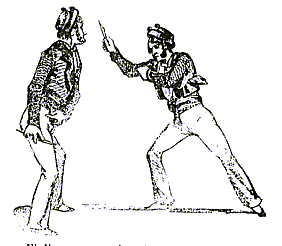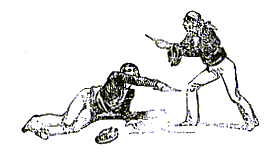
PART TWO
Of The Various Suertes That Are Executed In Tirar A La Navaja
Lesson One
GUARDIAS
You have already seen in our lessons in the first part of this Instruction; and to the extent that is reasonable for a short Manual like the present, the principle methods of offence and defence that have a place in the practice of the navaja; and we say the principle methods, because it is assured that there are as many as there are tiradores or barateros, and it is meticulous and dificult work to give a complete explination of each one.
Know, then, that the golpes and the quites, are essential to our purposes, we will proceed here to explain the mode of putting them into practice, once the combatants are to fight face to face; that is to say we instruct on how the diestro has to act according to the different guardia in which he finds himself, and what can be derived from aquired knowledge.
It is remarkable how much the quickness of the eyes aid in all kinds of suertes, when in guardia the diestro can approach his adversary until entering into his terreno, at considerable risk of being wounded, whenever he intends not to allow him to move the weapon arm; then when the slightest movement is made wound him in that same arm, obliging his adversary in this manner to stand without attacking. This suerte is very dangerous, because the two combatants share only one terreno where both may wound eachother without any movement of the feet, by only reaching out with the arm of the navaja.

The diestro can set up in guardia using either of the suertes, but with the express condition of not forgetting for an instant the position in which he is, or knowing the points of his body placed within reach of the weapon arm of the adversary.
We have sometimes seen the diestro lie down on the ground, using this suerte as his guardia, and it is in truth one of the most secure and with the least probability of being atracado, without the enemy putting himself in imminent risk of being wounded. The only easy way of attacking one who assumes this guardia is to recieve his golpes with a hat in the hand.

Whenever the diestro attacks his adversary he must attack the parte alta or parte baja, as we have discussed in its place; and from here it follows, that when striking a golpe he risks to recieve a blow in the parte opposite of that which he attacks; that is to say, if he strikes the parte alta he leaves his own parte baja uncovered, and if he strikes at the parte baja he leaves his parte alta uncovered.
It can be accepted as a general rule that the opportune moment in which the diestro should strike at his adversary is that in which, after having struck his golpe, the opponent withdraws the weapon arm that couldn't hallar carne*, to use an expression of the barateros. It requires much confidence, cautiously awaiting this moment so that it may be taken advantage of without delay; and if the objective is not obtained, it is necessary to withdraw your weapon arm quickly and as low as possible so as not to be attacked in turn at the instant of recovering.
*hallar carne: litteraly, "find meat", i.e. an attack stiking home